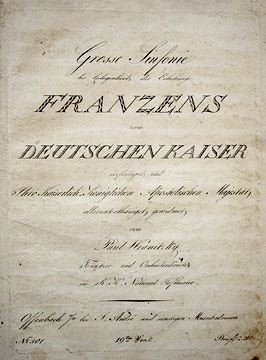Grosse Sinfonie op 19 - "Coronation"
 |
As orchestral director of the Viennese court theaters, Wranitzky was in a position to provide music for the nobility-often for important political events. Such an occasion availed itself in July when Franz II was crowned Holy Roman Emperor in Frankfurt. The musical culture of this city had already proven favorable for Wranitzky, as his opera Oberon had been performed in Frankfurt twenty-four times as part of the festivities surrounding the crowning of Leopold II in 1790. As further evidence of his importance to the Habsburgs, his "Joy of the Hungarian Nation" Symphony op. 2 was composed in recognition of Leopold's promotion of Hungarian independence. With these accomplishments, Wranitzky was the logical choice to provide music for Franz's coronation.
By composing for this event, Wranitzky's work must have been noticed by the publisher Johann André, who had a firm in nearby Offenbach. Though their business history began two years prior with André's publication of the "Joy of the Hungarian Nation" symphony, André seems to have become the primary publisher of Wranitzky's large works soon after this occasion. Perhaps even more importantly, this was also the beginning of the composer's position as local agent for André. During the ensuing decade, the two shared frequent correspondence in which Wranitzky described the musical scene of Vienna and arranged for the publication of his own works as well as those of others.
With its very special occasion in mind, the music of Op. 19 sounds expectedly festive and regal. Horns, trumpets and timpani figure prominently in the grand Andante maestoso introduction. After a majestic tone is established, the violins present the sweeping main theme, which is punctuated by the full ensemble. Each in turn, solo flute, oboe and bassoon color the sparkling secondary theme. The development section focuses mainly on the conversational nature of the secondary theme and bustling action of the transitional figures. All the main ideas are soon reprised as expected, but a brief new closing theme appears before the powerful and festive first movement reaches its conclusion.
Stark contrasts are the main objective of the middle movements. In addition to the general stylistic contrasts between the lyrical slow movement and the near-pompous sounding minuet, there is also great contrast within each movement. To stand out against the binding structure of the dance movement, Wranitzky offers a slow movement that is serenade in a hybrid form of ABA and variations. In it, solo winds provide a graceful melody that is both texturally varied by the strings and contrasted with a darker and rhythmically-aggressive middle section. In the dance movement, the ceremonious minuet is partnered with a lighter and folk-inspired trio section.
An air of anticipation, excitement and joy seems to permeate the entire Presto finale. Full of rhythmic drive and harmonic surprises and cast in sonata form rather than a rondo, the movement balances the grandeur of the opening Andante . The primary theme is set in a question/answer style and employs simple triadic motives and repeated notes. Its simple, building-block style lends it to be used in surprising ways, beyond its expected appearance in the development section. In one such instance, the P theme appears in the dominant directly following transitional material. This may lead the listener to assume that the movement is a monothematic sonata form, however, a new and contrasting theme-in the dominant-quickly emerges. The development and recapitulation successfully maintain energy and excitement and the symphony comes to an end with a reaffirming, grand cadence.
by James Ackerman
![]()
Symphony in C, op 19 |
| I. Andante maestoso - Allegro vivace |
432 bars |
| II. Andante con moto |
168 bars |
| III. Menuetto: Allegretto & Trio |
48+24 bars |
| III. Finale: Presto |
387 bars |
Scoring: 2 Vln, Vla, Vcl, B, Fl, 2 Ob, 2 Bn, 2 Hn, 2 Clno, Timp
| Download: | - Parts available upon request - |





